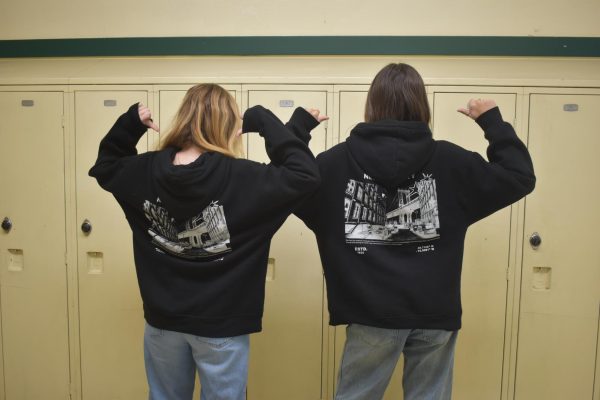Fast Fashion: How to change the way we shop
Clarion photo Becca McHaffie
A customer hits the racks.
Clothes are getting made quicker, cheaper, and worse. On top of that, the environment is taking hit after hit from companies like Shein, made to feed into this rapid supply and demand. All because of fast fashion.
So what is it? Fast fashion is the concept of low quality clothing made to be worn for shorter periods of time. Have you ever bought something from Forever21? How about Brandy Melville? Ordered from a site like Romwe or Amazon? Congratulations, you’ve partaken in fast fashion firsthand.
These clothes are often made in other countries (most likely from sweatshop labor) and exported to the US, where they are then sold to the masses. According to BusinessofApps.com, Shein, a popular online clothing store, made over $15 billion in sales in 2021. Although this may seem as simple as short-term clothing at low prices, there’s more to it.
Earth.org claims that fast fashion “comprises the depletion of non-renewable energy sources, emission of greenhouse gasses and the use of massive amounts of water and energy,” which pretty much sums it up. Every clothing company has to use water and energy, but fast fashion specifically uses a lot.
SustainableCampus claims that the fast fashion industry uses almost 80 billion cubic meters of water per year. And the water that isn’t used isn’t safe either. A good majority of the fast fashion giants don’t treat their wastewater. Dyes, cleaning chemicals, and other waste involved in the production process are dumped back into rivers and oceans carelessly.
Now that the facts are out of the way, what can we change about the way we shop? How influential is fast fashion truly, and how many people work to avoid it?
The first pattern noticeable is how normalized fast fashion is. All three teen girls interviewed had bought at least one thing from fast fashion retailers. Secondly, all of them knew how harmful it actually was.
“I know it’s bad, but it’s so hard because it’s so cute. Some of that stuff you can’t find at a thrift store and it’s just like right there, you know what I mean?” said Ella Monette.
When asked how she avoids fast fashion, she had a pretty popular strategy: thrifting. “I go thrifting a lot and I try to look at online secondhand stores like ThredUP and Poshmark, those sorts of things,” she said.
Thrift shopping has been shown to avoid landfill contribution, reduce carbon and chemical pollution, and lower overall water consumption according to Topicinsights.com.
“I thrift! I don’t buy anything new really, cause I don’t have that much money. Even ifI did have money, like enough money to buy fast fashion, I probably wouldn’t,” Lucia Bernardo said.
Lou Nunley agreed, saying “I try not to buy from ‘big’ companies, I buy from smaller ones. I have before, like Forever21 or or Shein, but I don’t anymore,”.
With secondhand clothing on the rise, it seems like teens are ahead of the curve shopping sustainably. That being said, thrifting isn’t the only sustainable fashion. Smaller businesses or companies with ethical codes regarding garment production serve as alternatives to fast fashion clothing. H&M, a fast fashion retailer, recently made a sustainability report in which they claim to have tripled the amount of recycled materials used in their clothing, as well as a 27.8% reduction in plastic packaging (according to H&M themselves). This is just one example of companies taking steps towards an environmentally ethical means of production. You don’t have to only wear used items to shop with the environment in mind, just be mindful of the new items you purchase and where they might be coming from.
Fast fashion is at the epicenter of the clothing world right now. Its accessibility and affordability comes at a cost to the environment, but fast fashion still persists as one of the largest industries in the world. While it may seem difficult to shop in a sustainable way, there are methods to shopping ethically and environmentally friendly.
My name is Lyrik and I'm a Sophomore at Cleveland. This is my first year on the Clarion and I'm the editor of Business as well as a reporter for Student...








